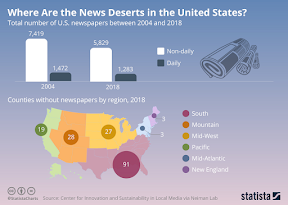In my second EOTO Presentation, I covered the topic of news deserts. A news desert is an area deprived from local news outlets. In the United States, these areas are specifically referenced as being the counties to a state. There has been a surge in news deserts observed from 2004 to 2018. Over this period, around 2,000 local outlets that would write weekly shut down, and over 200 daily outlets shutdown as well. There seem to be a number of causes to the issue. News companies are only selling physical newspapers, a market dominated by mainstream news outlets, and lack of intervention from the government.

More alarming though is that this surge has caused over 100 counties nationwide to be deprived of any local news outlets. These counties are both urban and rural. They typically are economically vulnerable and or have a sizable minority population. While those are the commonplace areas, wealthy counties have also lost all of their local news as well. Montgomery county in Maryland, the seventeenth most wealthy county nationwide, is also a victim to being a news desert. Without these news outlets there has been a decrease in civic engagement, a lack of local knowledge, and lowered the amount of democratic practitioners in these counties.
This situation has also affected the job market as well with over 40,000 journalists leaving the profession entirely. Many of the still struggling local outlets are being bought up by Gannett and Lee Enterprises. This company has one of the largest networks of news outlets in the country. Even as publishers try to go digital, it appears the void from all of the closed outlets is still being felt as well.
Ghost newspapers have also cropped up during this time as well. Ghost newspapers are a part of news deserts. The key difference is instead of a publisher shutting down, the publisher simply does not have any or enough journalists reporting on local events. These only add fuel to news deserts because it may seem like there are local publishers, but they never publish about local events.
As this problem continues to grow, the more damage we as a nation will feel. If we are disconnected from our community, how are we ever supposed to feel connected as a nation? People have begun to try to find solutions to these problems. Some are more easily done than others. A change in business model for local outlets is a popular solution. For too long they have solely relied on physical sales of their articles. Getting more publications onto the internet will hope these outlets reach a larger audience. Searching for investors from philanthropic or venture organizations also seems to be a popular idea as well. With the funding of new publications, that "void" mentioned early might be filled faster with the creation of new local outlets. Most people, however, want either the state or federal government to help out. This can be in the form of tax incentives or creating financial relief to some capacity. Hopefully with any of these possible solutions in motion, the loss of local newspaper will at least stop. Until then though, we will most likely see the number of news deserts only grow.
No comments:
Post a Comment